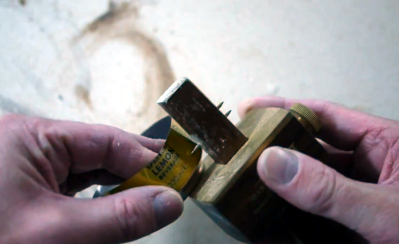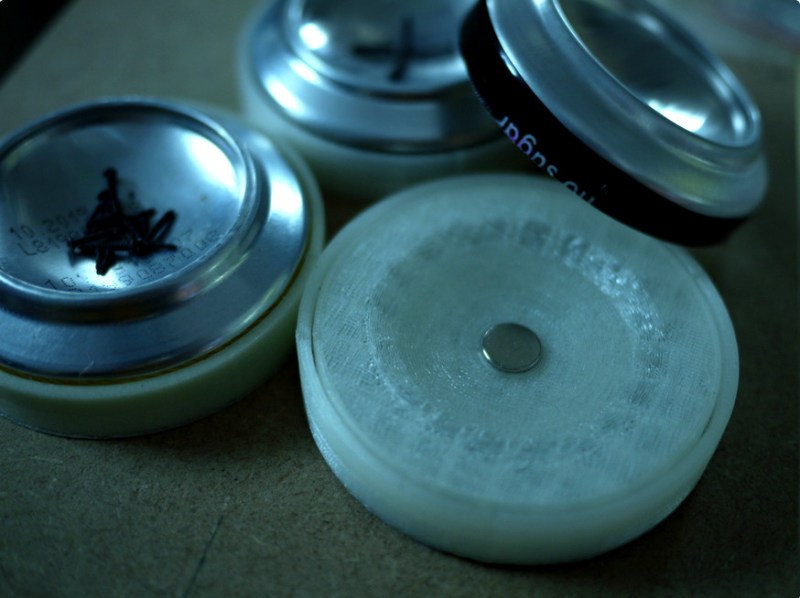If there’s any one thing that the average hacker is short on at a given moment (besides chips), it’s transient small part storage. Just as new projects are built from small parts, diagnostics and teardowns of commercial equipment invariably result in small parts. We think [amenjet] may have the answer — small parts holders made from the bottoms of soda cans.
 You start by cutting the bottom off of an empty can however you like. In the first video after the break, [amenjet] scores the can on what could be a purpose-built jig before cutting along the line with tin snips, but you could use regular scissors if that’s all you have. Then it’s just a matter of shoving it into the circle around the perimeter of the print to secure the sharp edge.
You start by cutting the bottom off of an empty can however you like. In the first video after the break, [amenjet] scores the can on what could be a purpose-built jig before cutting along the line with tin snips, but you could use regular scissors if that’s all you have. Then it’s just a matter of shoving it into the circle around the perimeter of the print to secure the sharp edge.
The underside of the print is graduated and ends with a small hole fit for a disc magnet. To keep the prints from scratching the table, [amenjet] covered the bottoms with crushed velvet. After making about a dozen of these things, they CNC’d a tray to hold three of them, which you can see in the second video. Each cavity in the tray is lined with more crushed velvet for elegance and stability.
Between the concavity of the can bottom and that little lip, it should be particularly easy to actually retrieve a tiny part from the pile and grab on to it. Between the utility and the recycled aspect, this could easily be an entry into the second Challenge of the 2022 Hackaday Prize, which runs now until Sunday, June 12th. This round is all about reusing, recycling, and revamping anything and everything to keep it out of the landfill. Start your entry today!
















Wouldn’t it be easier just to fill the base of the can with resin ?
3D printing the base is Ok, but they take a lot longer time than pouring and wait for the resin to set.
Since the part is unseen, you can even use cheaper car repair bondo.
You could just staple a bunch together also. One might be a bit jittery and skittery, but 4+ stapled together, less so.
My first thought upon seeing the 3D printed insert was, “you’re already printing out something that has the same concave shape to it. Why not use that as the tray and eliminate the need for the can bottom?”
I came to say exactly this… I’ve already engaged a 3D printer. The other work is just unnecessesary.
The can bottom is also a perfectly servicable mold… just fill it with chopped up PET bottles and heat.
If I had a dollar for all the projects I ever think of that would be nice to do with resin…
I might actually be rich enough to buy a container of resin.
Ok, it’s not really that expensive that I couldn’t buy some if I wanted to but I don’t because it is (IMHOP) too expensive for use in any old common every-day project and I still have plenty of more practical skills to develop using more commoditized supplies.
It’s a shame though, it looks like some good things can be done with resin. Is there a secret supplier the aficionados all go to who doesn’t charge an arm and a leg for the stuff?
Sorry, I missed the Bondo line on the first read. Still curious about getting good clear resin though.
I think the secret supplier is “getting sponsored by TotalBoat”… I also wish I knew a cheap place to get it. There’s not even platinum in resin unlike two part silicone…
All depends on what you call expensive doesn’t it (and perhaps where you live, round here in the UK I’ve found a few good suppliers at sensible prices) – I’ve done lots of oddities with resin and silicone and find most of the time the bottle/tin lasts well over its ‘shelf-life’ after doing the project(s) it was bought for and is still good enough to use at that point for many things…
If you are doing a big resin project sure you can eat £30 worth pretty trivially, but the volume it fills in whatever weird shapes you end up with would be expensive to fill in other ways too, either in time or alternative materials.
For something cheaper and similarly useful for many projects the expanding polyurethane 2 part foaming stuff is great value, and a tiny tiny amount goes way further than you think it will (often to messy results) – and if its constrained against something like in this case a cut off beverage tin the skinned surface it creates is smooth and tough.
I’m sticking with gridfinity.
If the plastic piece is as large as the can bottom, why not use the plastic piece and avoid the can bottom altogether?
I was thinking the same thing
The print layers leave a series of steps that aren’t totally smooth, The small screws and whatnot get caught on them making it harder to slide the parts to the edge of the can. The lip at the edge of the can is useful for holding the part while you grab it with a fingernail.
If you’re CNC’ing a base from wood, why have the 3D printed parts when you could CNC the shape directly into the wood and not have to 3D print anything either?
Re: Keeping things out of landfill.
As a younger man, I repurposed no end of stuff from the local skips and dumps, but alas that is no longer allowed, as once the council gets something in their skip, it is going to landfill irrespective of its potential second life. They have high fences surrounding their skips, and locked gates if it is not ‘working hours’, and then they complain bitterly that people fly tip by their gate. The idea of not locking the skip up for 17 hours a day is obviously a solution they can’t use due to insurance issues. If someone pulled a muscle removing something from a skip, they could potentially sue the council for having it accessible. I have realised that the word ‘progress’ is not always a good thing.
Yes lots goes to waste purely due to regulatory red tape. We used to have a anual kerbside colection of “bulky” goods this was a recyclers paradise. You could cruise the streets for the week prior to the collection looking for stuff to collect. Swings bikes radios computers tv’s satellite dishes. Now they have replaced that with “free” bulky goods dumping days so you need to take your stuff to the tip and no one gets to forage through the goods.
The whole talk of recycling is just hot air from governments to earn them “green” credentials.
That’s not my experience of council WRC’s – if you want something and are willing to pay the totters a few quid for it they’ll fish it out, and they have their separate area full of stuff they’ve already fished out and put on sale.
My local electronics store smashes all their customer returns so they can’t be scavenged out of the bin, AND they lock the bin. Fuck you, Jaycar.
Over two minutes of spead-up video of a 3D printer???
Spead-up?
I just thought that it was a demo of a new very fast 3D printer. If I had a printer that could print this fast, I would be showing it to the world too. But, perhaps I’m wrong? And perhaps that scene, where superman is flying around the world so fast that time turns backwards, is a time lapse too? Darn… is nothing real anymore? What’s next superman does not exist, he’s just an actor… I’m just going to sit quietly in a corner for the rest of the day…
“scores the can on what could be a purpose-built jig“
This is a woodworking tool called a marking gauge.
There is no need to cut the can at all. Just turn it over upside down. Have been using these forever to mix epoxy. I appreciate that this build is going for but if whatever you are putting in the dish is nondestructive then there is non need to use a semi-disposable dish.
i can see video:
—-
Our systems have detected unusual traffic from your computer network. Please try your request again later. Why did this happen?
Devil’s advocate here.
Aren’t we overusing 3D printing for everything now, reinventing every wheel? Just the other day I read some DIY article that called for a 3D printed plastic square with a hole near a corner, what could have been wrong with a simple scrap of acrilic and a drill? Don’t get me wrong I’m first in line to 3D print some moderately complicated piece, but …
But regarding the topic of this article, I use a simple disposable (ready-made!) pill tray like this https://sc04.alicdn.com/kf/HTB1q4ZrSFXXXXXkXFXX760XFXXXi.png
I’ve used an egg carton in the past to hold small nuts and bolts while working on my car.
I put them in a particular order and reverse the order when I’m putting things back together.
I’ve used chococate boxes for small stuff (laptop or phone etc) disassembly before now also.
Then there’s the stab 8 holes in a tissue box with a sharp pencil to keep your valves in order when doing a top end overhaul trick.
tissue box eh?
then, I ruined a decent 3×3 board drilling holes in it for valves.
Full marks for the idea.. I use soda can bottoms for things that require metal, like melting waxes and holding solvents.
I have a different option for transient small-part storage though: chemist’s weigh boats:
https://www.amazon.com/s?k=weigh+boats&i=industrial&sprefix=weigh+bo%2Cindustrial%2C169
They’re cheap, sold in bulk, and are designed to fold into a pour spout so you can dump things out in a controlled manner.
If you are out know a machinist, the boxes carbide inserts come in are good for storing small screws. They’re compartmentalized and have a sliding lid you can write on.
Really wish these articles would stop using CNC as a noun or verb, though.
I cut egg cartons in half for small parts and Temptations Mega-size containers (which my cats empty at a fast rate) for larger parts and even storage for completed projects.
You could have used a 3D printed soda can cutter.
https://www.thingiverse.com/thing:3658526
Its very usefull tool not just for can’s but also you can mark out circular pipes.
On the re-use front myself i use mcdonald’s tomato,bbq sweet and sour sauce plastic tubs. There about 42mm x 52mm including the rim and 25mm deep. Good for small screws and small quantity’s of electrical components. I can also arrange them in a sandwich box. If only the top were re-sealable they would have been perfect.
Could be a good article of what do you re-use or up-cycle to store components.
This seems like a major waste of effort in the execution on what is otherwise a great idea – surely what is wanted is to 3d print or CNC exactly ONE former – then you simply push the cut can onto the former and have the that cut edge neatly rolled over (probably with the aid of a small hammer to make it follow the form neatly).